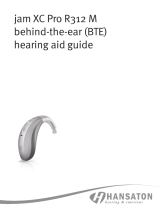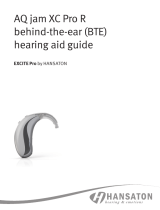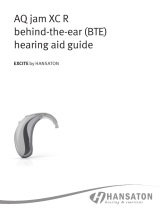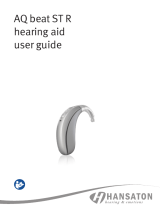Page is loading ...

beat
Behind-the-Ear Hearing System (BTE)
Instructions for Use
GB


Your Hearing Systems
Hearing healthcare professional: ___________________
_________________________________________________
Telephone: _______________________________________
Model: __________________________________________
Serial number: ___________________________________
Replacement batteries: Size 13 Size 675
Warranty: ________________________________________
Program 1 is for: _________________________________
Program 2 is for: _________________________________
Program 3 is for: _________________________________
Program 4 is for: _________________________________
Date of purchase: ________________________________

Quick Reference
Changing Batteries Low Battery Warning
2 beeps every 30
minutes
13
675
On/Off
Lever
Volume control; up=louder, down=softer
Push Button
Switching programs
Volume control; right aid=louder, left aid=softer
On Off Open
Plus (+) signs

Table of Contents
Your Hearing Systems at a Glance ..................................2
Putting Your Hearing Systems on Your ears ..................4
Turning Your Hearing Systems on and off .....................5
Battery Information .........................................................6
Tips for Wearing Hearing Systems for the
First Time ..........................................................................9
Operating Instructions .................................................. 11
Using the Telephone .....................................................15
Caring for Your Hearing Systems ................................. 17
Cleaning Your Hearing Systems ...................................18
Signature Features of Your Hearing Systems ..............20
Assistive Listening Devices ...........................................22
Troubleshooting Guide .................................................23
Warnings ........................................................................ 27
Warning to Hearing System Dispensers
(to Comply with the U.S. Food and Drug
Administration (FDA) Regulations) ..............................30
Compliance Information ...............................................35
Patient Feedback ........................................................... 37
Additional Notes ............................................................38

2
Your Hearing Systems at a Glance
1 Earhook – your custom made earmold attaches to
your hearing systems using the earhook
2 Microphone – sound enters your hearing systems
via the microphones. Microphone shield – protects
microphones from dirt & debris
3 Push button – switches between listening programs
or changes the volume level or SurroundOptimizer,
depending on your customized fitting
4 Lever – controls either the volume or
SurroundOptimizer, depending on your customized
fitting
5 Battery door/on & off – close the door to turn on
your hearing systems, partly open the door to turn
off your hearing systems. Opening the door all the
way gives you access to change the battery
6 Earmold – allows the sound to pass from the
hearing systems to the ear and holds the hearing
systems in place
7 Power slim tube – sound travels down the tube to
the ear canal
0124
Conformity to directive
93/42/EEC concerning
medical devices

3
2
3
4
5
2
3
4
5
1
6
7
6

4
Putting Your Hearing Systems on Your
Ears
Your behind-the-ear (BTE) hearing systems may be
color-coded with a small dot on the battery door:
red = right ear; blue = left ear.
BTEs with Earmolds
1. Hold the earmold between
your thumb and index finger.
The opening should be point-
ing in towards your ear canal
with the BTE resting upwards
over the top of your ear.
2. Carefully insert the earmold
in your ear. You may need to
twist it slightly to the back. The
earmold should fit into your
ear snugly and comfortably.
Pulling down and back on your
earlobe may help you insert
the earmold into your ear canal
more easily.
3. Place the hearing system over
the top of your ear.
1.
2.
3.

5
Turning Your Hearing Systems
on and off
Your hearing systems have a three-position battery
door that acts as an on/off switch
and that allows access to the bat-
tery compartment.
1. On: Close the battery door
fully.
Note: It may take 5 seconds be-
fore the hearing system turns on.
Your hearing healthcare pro-
vider can additionally increase
the start up delay if required.
2. Off: Partially open the battery
door.
3. Open: Fully open the battery
door to access and change the
battery.
Note: When turning your hear-
ing system on and o while it
is on the ear, grasp the top and
bottom of the device with your
index nger and thumb. Use
your thumb to open and close
the battery door.
3.
2.
1.

6
Battery Information
To replace the battery, fully open the battery door for
access to the battery compartment.
Low Battery Warning
Two long beeps indicate the hearing system battery
is low. After the low battery warning, you may experi-
ence some reduction in sound quality. This is normal
and can be remedied by inserting fresh batteries into
the hearing systems.
If you are not able to hear the low battery warning,
your hearing healthcare professional can change the
pitch or loudness of the low battery warning. If you
prefer, it can be turned off entirely.
Your hearing systems are designed to generate a low
battery warning every 30 minutes until you change
the batteries, but depending on the condition of the
batteries, they may die before another low battery
warning occurs. erefore, it is recommended that
the batteries are replaced as soon as possible once
you hear the low battery warning.

7
Replacing the Battery
1. Gently swing out the battery door
with your fingernail.
2. Grasp the battery with your thumb
and index finger and remove.
3. Insert the new battery into the bat-
tery compartment with the plus (+)
sign on the battery facing the same
way as the plus (+) sign on the side
of the battery door. This will ensure
that the battery door closes properly.
Note: If the battery is inserted incor-
rectly, the hearing system will not turn on.
4. Close the battery door.
2.
3.
1.
4.

8
Replacing the Battery in Hearing Systems
with a Tamper-Resistant Battery Door
Your hearing instrument may have a
tamper-resistant battery compart-
ment.
1. Unlock the tamper-resistant bat-
tery compartment by pulling the
white lever with your fingernail
and lift the lever up to release the
battery. Remove the battery.
2. Insert the new battery into the
battery compartment with the
plus (+) sign on the battery facing
the same way as the plus (+) sign
on the edge of the battery door.
Lower the lever onto the battery
and push it is until it is locked and
securely holds the battery tight.
3. Close the battery door.

9
Caring for Batteries
Always discard batteries in a safe and environmentally
friendly way.
To prolong battery life, remember to turn your hearing
systems off when not in use.
Remove the batteries and keep the battery door open
while hearing systems are not in use. This will allow
internal moisture to evaporate.
Tips for Wearing Hearing Systems for
the First Time
1. Start in a quiet room at home first to get used to
the new sound quality. Sounds like the ticking of a
clock, the humming of the computer, the beep of
the microwave or the rustling of clothes or paper
may seem loud to you at first, because you have
not been hearing them properly for a long time.
2. Read aloud to yourself and learn to correct the
volume of your own voice when you are wearing
the hearing systems.
3. Talk to different people and learn how to distin-
guish between different sound patterns again.
4. It will take some time before you are completely
used to your hearing systems and can fully enjoy
the benefits.

10
5. Wear your hearing systems for as many hours a day
as you can, and for a little longer each day.
6. Make notes at the back of this booklet, write down
difficult situations and describe what any unpleas-
ant noises were like. This information will help your
hearing healthcare professional to fine-tune the
devices better for you.
7. Involve your family and friends in this familiarization
period. For example, ask someone to set the televi-
sion to a comfortable volume.
8. When you are beginning to get used to wearing the
hearing systems, wear them in more difficult listen-
ing environments such as the office, at parties or in
restaurants. This can be difficult even for people
who can hear normally. Give yourself time to regain
your ability to hear in these difficult situations.
9. Make your hearing systems part of your everyday
life and be patient with yourself until you have
retrained yourself to interpret the sounds correctly.

11
Operating Instructions
Your BTE hearing systems come with two controls that
allow you to further adjust your hearing systems – a
lever and a push button.
Lever
The lever on your hearing systems can be
set up as either a volume control or a
SurroundOptimizer.
Volume Control
If the lever has been configured as a volume control,
you can adjust the volume of your hearing systems.
Press up to increase; press down to decrease. As you
change the volume level, your hearing systems will
beep.
Volume setting Beeps
Recommended volume level 1 beep
Turning volume up short beep
Turning volume down short beep
Maximum volume level 2 beeps
Minimum volume level 2 beeps

12
Tamper-Resistant Cover
Some hearing systems are fitted with
tamper-resistant covers instead of levers to
prevent someone from accidentally adjust-
ing the hearing systems. The cover can still
be used to make adjustments but it requires
using a fingernail or a small tool to push up
or down.
Push Button
Your hearing systems are equipped with a push button
which can be set for switching between programs, to
adjust your volume or adjust the SurroundOptimizer.
Program Control
If the push button has been configured as a program
control, each time you push the button, you will move
to a new hearing system program.
Your hearing systems beep to indicate which program
you are in.
Program 1
(e.g. Auto Program) 1 beep
Program 2 (e.g. speech in noise) 2 beeps
Program 3 (e.g. PhoneConnect) 3 beeps

13
Program 4 (e.g. music) 4 beeps
PhoneConnect (see pg 15) short melody
Auto-DAI (see pg 22) short melody
Wireless synchronization
(if enabled, see pg 14) Opposite ear beeps
the same as side being
adjusted
Volume Control
If the push button has been configured as a volume
control:
• Push the button on your right hearing system to
increase the volume in both hearing systems.
• Push the button on your left hearing system to de-
crease the volume in both hearing systems.
Volume setting Beeps
Recommended volume level 1 beep
Turning volume up short beep
Turning volume down short beep
Maximum volume level 2 beeps
Minimum volume level 2 beeps

14
Wireless Synchronization (BiLink)
If wireless synchronization is enabled, then changing
the volume or program setting on one hearing system,
will automatically make the change to both hearing
systems at the same time. Wireless synchronization
works for both the push button and the lever.
For example, if your push button is configured as
a program control and wireless synchronization is
enabled, when you push the button on your right hear-
ing system, the program will change in both hearing
systems.
Remote Control
Your hearing systems may also come with an optional
remote control which allows you to switch between
different listening programs, and change your volume
or SurroundOptimizer settings.

15
Using the Telephone
As telephones do not all work the same, you may
experience different results from different phones. You
can use many phones by simply holding the receiver to
your ear, without the need to change to a dedicated
telephone program on your hearing systems. Remem-
ber to move the handset slightly up or back to find the
position that sounds best to you.
Depending on the phone type you use, your hearing
healthcare professional might have selected a dedi-
cated phone program on your hearing systems. Your
hearing systems may have an automatic telephone
program (PhoneConnect feature), which automati-
cally switches to a dedicated telephone program
when a telephone receiver is brought close to one of
your hearing systems. You will hear a short melody
to indicate you are in the telephone (PhoneConnect)
program.
When the receiver is moved away from the hearing
system it will automatically return to the previous lis-
tening program. If wireless synchronization is enabled
on your hearing systems for the automatic telephone
program, both hearing systems are synchronized and
the listening program for the opposite ear will also
change when the automatic telephone program is
activated.

16
If the hearing system does not switch to the telephone
program automatically when the telephone receiver
is placed in proximity, the magnet for PhoneConnect
hearing systems should be attached to the telephone
receiver. The magnet is designed to strengthen the
magnetic field at the ear piece of hearing system com-
patible telephones.
To Affix the Optional Magnet:
1. Clean the telephone receiver. Hold
the magnet near the “listening
end” of your telephone receiver and
release it. The magnet will flip to
the appropriate side and seek the
optimal position on the telephone
receiver.
2. Place the double-sided tape in this
optimal position on the telephone
receiver.
3. Attach the magnet to the tape.
Your hearing healthcare professional
may also have set up a phone program
that you can access through the push
button on your hearing systems, or through your
optional remote control.
If your hearing systems are configured to work with
the wireless uDirect 2 neck worn accessory, you might
/











